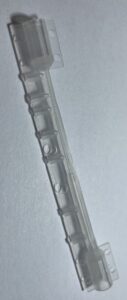Haemograph’s trailblazing rheometer transforms surgical safety by providing precise clotting data, helping clinicians balance clot prevention and bleeding control.

Imagine a world where surgery is safer and more efficient, thanks to advanced technology that ensures proper patient blood management before, during and after surgery.
When you’re injured or have surgery, your blood naturally clots to prevent excessive blood loss. However, this life-saving process can also increase the risk of a clot forming inside a deep vein, most commonly in the leg, leading to deep-vein thrombosis (DVT).
To prevent blood clots, anticoagulant medications are often used during surgery and post-operative recovery. These medications thin the blood by disrupting normal clotting factors, making it more difficult for clots to form. However, blood thinners can also lead to excessive bleeding, so they may need to be tapered off and reversal agents given to prevent haemorrhaging.
A surgical team treads a fine line between a patient developing dangerous blood clots or bleeding excessively.
Anticoagulant therapy often involves trial and error when determining the right blood thinner, dosage and reversal agent for each patient. Since the best approach can vary from person to person, adjusting these factors in real-time during surgery and throughout recovery is crucial for the best patient outcomes.
Like many liquids, blood behaves differently depending on flow conditions. Circulating blood experiences different shear rates in arteries, veins and capillaries and vessels of different diameters.
Given the complexities from patient variation and shear rate dynamics, clinicians require a diagnostic device that provides real-time, accurate information during surgery and post-operative care.
Enter the rheometer, a device that measures liquid properties related to viscosity, i.e. measures of how ‘thick’ a liquid is.
A blood coagulation rheometer assesses key clinical parameters such as the patient’s clot formation time, clot strength and clot structure.
Current blood clotting measurement methods are generalised, time consuming and static. An accurate, rapid and individualised system is needed to predict patient reactions to different drug combinations and monitor clotting during operations, helping healthcare providers make more informed decisions on the spot and improve patient outcomes.
This is where Haemograph comes in.
Haemograph is a Melbourne-based startup revolutionising surgical care with their innovative portable, point-of-care, blood coagulation rheometer. Requiring only a small blood sample, the rheometer delivers real-time results on clotting time, clot strength and other clot formation dynamics. The system can test a single blood sample against up to 6 medications at once, aiding in clinical decisions on drug selection and dosing by predicting adverse reactions to anticoagulants and identifying the most effective reversal agents.
Haemograph’s rheometer can measure blood rheology at various diameters, which is crucial for understanding how blood clots form under the different shear rates found in arteries, veins and capillaries, elevating the device above other products on the market and providing a more comprehensive picture of clotting behaviour.

To achieve this, Haemograph needed to create microfluidic channels featuring multiple long, thin cylinders in series, with several ports connecting them. It was crucial for the rheometer’s channel dimensions to be reproducible with minimal errors. The development of this advanced technology was made possible through collaboration with CSIRO and ANFF-VIC’s Melbourne Centre for Nanofabrication, from prototype fabrication with precision 3D printers to essential support and training for the Haemograph team.
By providing fast, accurate information to clinicians, Haemograph’s rheometer will guide medical professionals in administering the correct dosage of anticoagulants and reversal agents during surgeries and other medical procedures like dialysis, enabling them to successfully walk the tightrope between clotting and bleeding and ensuring better patient outcomes.
Published 15 October 2024 in ANFF’s 2024 Casebook ‘ANFF NEXT‘
Posted 22 July 2025
